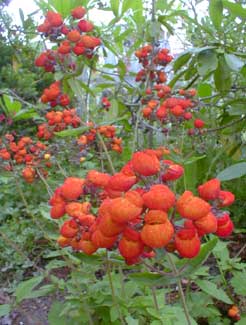 'Kentish Hero' Slipperwort; aka,
'Kentish Hero' Slipperwort; aka,
Lady's Slipper, Pouch Flower, or
Pocketbook Plant
"On a bank of flowers, in a summer day,
For summer lightly drest,
The youthful, blooming Nelly lay,
With love & sleep opprest."
-Robert Burns
(1759-1796)
(1759-1796)
 We bought our first 'Kentish Hero' slipperwort out of the boldly signed "Perennial House" of one of our favorite nurseries. Although it is occasionally to be regarded as a short-lived tender evergreen perennial subshrub, expectations should be kept low, as the species is all too often, for all practical consideration, transient in the garden.
We bought our first 'Kentish Hero' slipperwort out of the boldly signed "Perennial House" of one of our favorite nurseries. Although it is occasionally to be regarded as a short-lived tender evergreen perennial subshrub, expectations should be kept low, as the species is all too often, for all practical consideration, transient in the garden.Nevertheless, of the two pots of Calceolaria integrifolia 'Kentish Hero' we planted in 2003, one of them made it through quite a cold winter (not as an evergreen in our zone) & was back in full bloom the following June, plus we obtained another small start earlier that spring, & it as well as the previous one returned bigger & more exciting in 2005.
 So two out of three plants have made it through winters in protected spots despite their tenderness.
So two out of three plants have made it through winters in protected spots despite their tenderness.We have another species, Calceolaria biflora 'Goldcap,' which is likewise tender in our zone, allegedly slightly more likely to perenialize, though I plant them as annuals & if a few come back a second year, great, but I don't hold my breath. In our garden 'Kentish Hero' has proven longer lasting.
Other species with larger slippers are sold as houseplants, are extremely delicate, & generally discarded as soon as they stop blooming. These hybrids are typically tagged as C. x herbeohybrida, & are crosses most often of C. crenatiflora, C. corymbosa, & C. cana.
Such hybrids die rapidly if planted outdoors at much below room temperatures, & expire almost as rapidly if exposed to much sun & heat. Only the two species represented by 'Goldcap' & 'Kentish Hero' can be grown outdoors & with moderate luck may even perennialize.
The species C. integrifolia was formerly C. rugosa. Whether the cultivar 'Kentish Hero' perenializes or is transient in the garden, it at the very least does excellently outdoors until weather turns frosty.
It's an old variety which starts out with speckled but predominantly yellow flowers that rapidly age oranger & oranger, until it is an almost blazing orange-red. The first two July photos are from 2003; the third photo is from June 2004. The final photo below is from mid June 2005.
 Its puffy flowers give it its common names Slipperwort, Pocketbook Plant, Pouch Flower, or Lady's Slipper.
Its puffy flowers give it its common names Slipperwort, Pocketbook Plant, Pouch Flower, or Lady's Slipper.Given plenty of sun (or not more than a little shade) together with persistent moisture, this native of Guatemala grows into an upright shrub of a foot or so in height (ours exceeded two feet in its third year), with compact foliage, producing huge numbers of the amazing blossoms from late spring to October.
 It is named after Caratacus (also rendered Caradog or Caradwg), chief of the Catuvellauni.
It is named after Caratacus (also rendered Caradog or Caradwg), chief of the Catuvellauni.Caratacus was "the first Kentish Hero," who defeated Emperor Claudius's troops at Colchester in Essex.
He resisted Rome for nine years, until 51 C.E., until finally, retreating into Wales, Cartimandua the warrior queen of the Brigantians gave him into captivity.
His portrait is shown on a Celtic-Roman coin found in 1984 at Wanborough, Surrey, where a Roman temple was excavated. Now displayed in the National Museum of Wales, the front has Caratacus's face & the letters CARA. The reverse has an Eagle grasping a snake.
After his capture by Queen Cartimandua, he was sent in chains to Rome, where he gave such a rousingly defiant speech to the Senate that all admired him.
He lived out his life with his family in Rome. It's amusing to picture him in retirement wearing bright orange slippers like the flower today named for him.